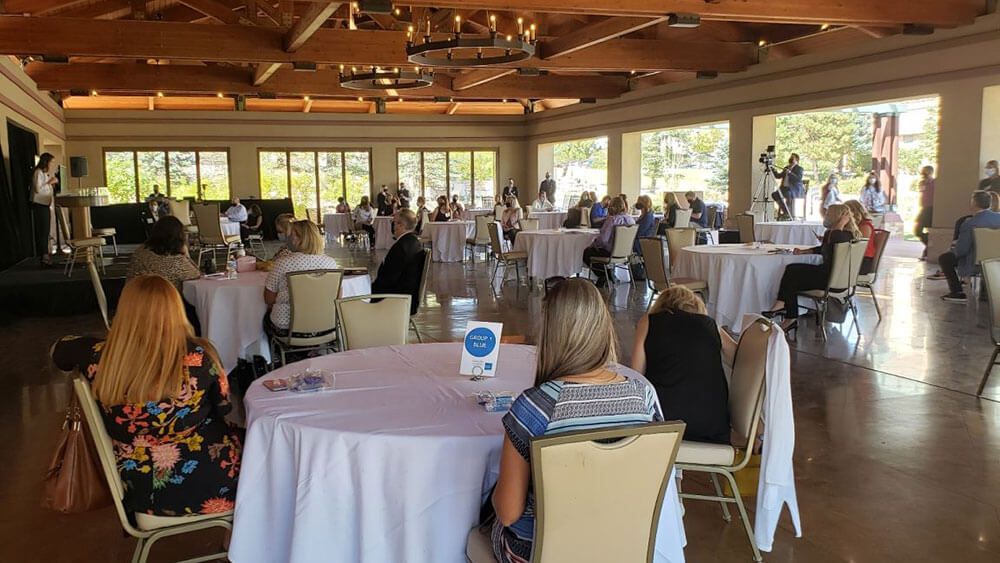
Organizers of the 6-Foot Laboratory hybrid event in Broomfield, Colorado, utilized spaces open to the outdoors at the Omni Interlocken as much as possible.
“We basically got tired of sitting around doing nothing.” That’s how Megan Martin, CMP, DES, president of PCMA’s Rocky Mountain Chapter, described what prompted chapter leaders to plan an in-person event during the pandemic, held Sept. 3 at the at the Omni Interlocken Hotel in Broomfield, Colorado.
“We wanted to provide a service that would help our members get back to work,” Martin, manager of partner events at RingCentral, said. “And so, from that idea, we thought about how do we get people back into live events again.”
Martin said chapter leaders recognized that planner members are apprehensive to host an in-person event themselves because the “consequences are large.” So, the chapter decided to organize a “laboratory experience” for them, taking the risks themselves. The event, from 1 p.m. to 6 p.m., was called the 6 Foot Laboratory — alluding to the distance public health officials recommend as sufficient space to prevent transmission of the virus.
Martin said they got a sense of the appetite for an in-person event based on a Mini Golf Tournament the chapter hosted Aug. 6. “The response from that was over the top,” she said, which gave them confidence in planning for the Sept. 3 event.
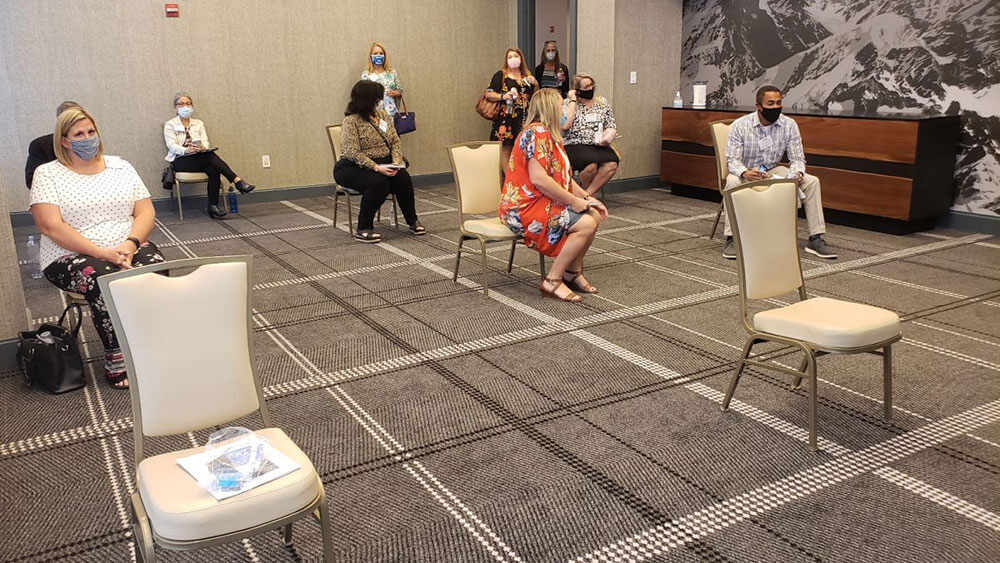
Each of the four educational sessions, where experts talked about hotel experiences, audiovisual, and food and beverage considerations, featured a different room setup.
Distance Learning
A total of 62 planners and suppliers, evenly split, attended the event at the Omni Interlocken, which was chosen in part for its outdoor pavilion, where much of the event — including a networking reception — took place.
“We tried to keep it outside whenever all 62 people were together,” Martin said. “It was safer, plus everyone was required to wear a mask, except if they were eating or drinking.”
Attendees moved inside the hotel to four different rooms or experiences, each with a different room setup and subject-matter expert talking about hotel experiences, audiovisual, and food and beverage considerations at an event held during the pandemic. In addition, Martin said, “we had a DMC there so people could engage with them and say, ‘Here’s the problem I’m having. Can you help me figure it out?’ or ‘What is the best practice for a particular situation?’”
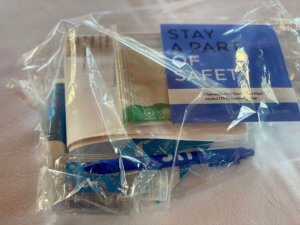
The welcome packet included not only the usual name tag, pen, and chapstick, but also a face mask and alcohol wipes.
The goal was to make the sessions highly interactive. Not only did participants hear about “how to hold an in-person event today, what it would take to move people around, or how to serve food and beverage” at breaks and meals, Martin said, they saw for themselves what that looked like. “It was really teaching people how to do live events again in this new six-foot space we’ve found ourselves in,” she said.
Bigger Reach
Martin was pleased with the turnout, but “the most exciting part, being a member-based organization,” she said, “is that we really focused on outreach this year, and so it was really nice to see that about 25 percent of our attendees were non-members.”
Members paid $35 and nonmembers $45 for the live event. Registration for the digital component to the event cost members $20; nonmembers paid $30.
It was the chapter’s first time hosting a hybrid event, Martin said, and it wasn’t without its tech issues — not the least of which was working with a platform provider who bailed 10 days before the event because they weren’t ready to provide what had been promised.
Martin said they scrambled to find a replacement and while “the platform we built and the workaround was actually really seamless and got the highest ratings because of how easy it was to use, it didn’t provide for a lot of interactivity among attendees who are online, which is really what we were hoping for.” The platform had a moderated Q&A, but not a chat feature. “So, that was a big miss for us,” she said, “and then we just had Wi-Fi issue after Wi-Fi issue.”
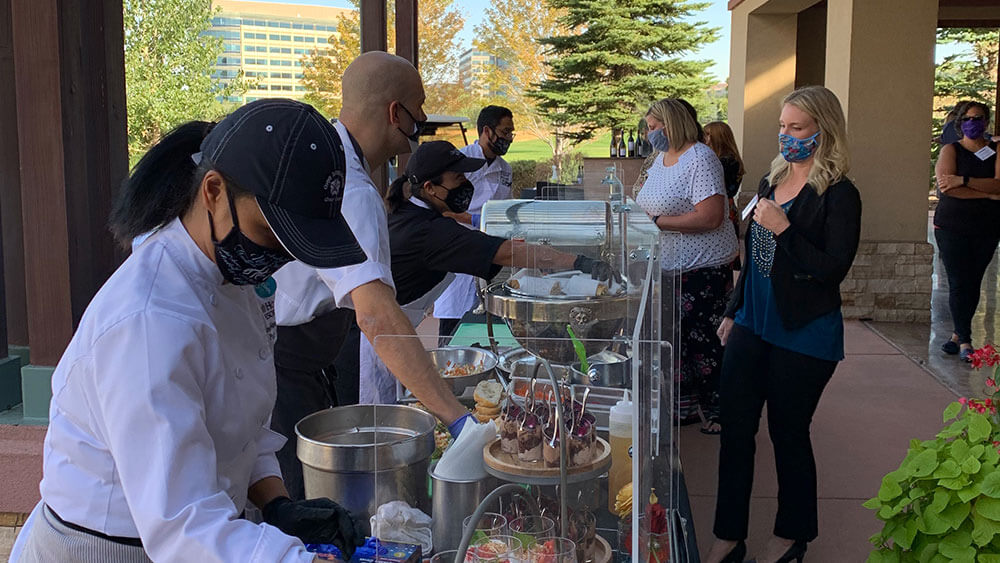
At the outdoor reception, participants picked up a tray and went through the line to get their food, served by staff members.
New-Style Networking
Holding the networking reception outside gave participants flexibility in where they chose to sit. “We had twice as many tables [as needed] so people could spread out and pick and choose how comfortable they were engaging with other people — we had a lot of different seating options depending on your comfort level, throughout the pavilion and lawn. This allowed people to be outside and keep their distance from others, both critical to staying safe and healthy while masks were off while eating and drinking.”
The food and beverage setup was “kind of a buffet, which is very non-traditional for a reception,” she said. Participants picked up a tray and went through the reception line to get their food, and then they ate it at their table. Going back for seconds was discouraged, Martin said, and no servers came around to offer them more, in order to limit interactions.
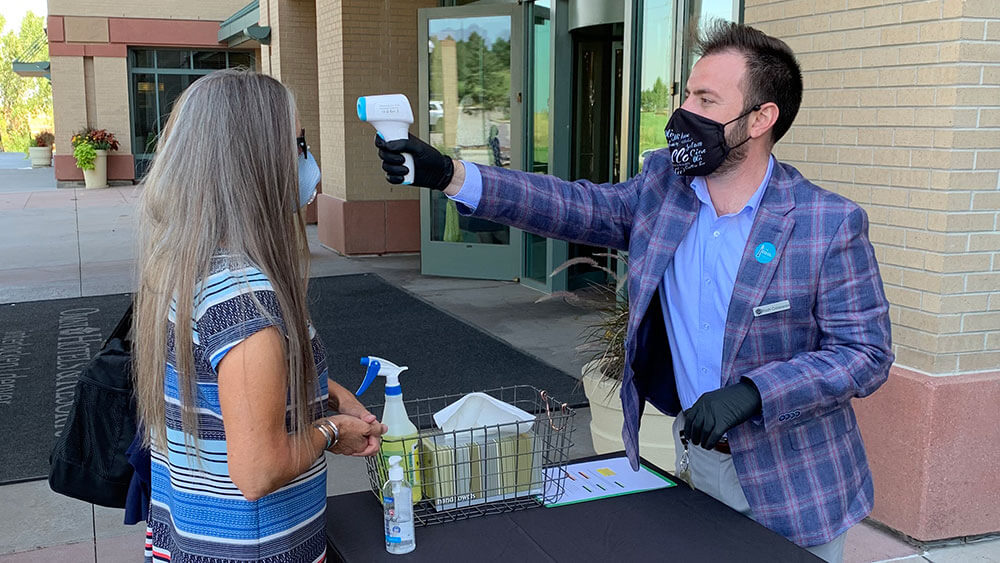
The Hotel Interlocken’s human resources director put attendees through the same temperature screening process that hotel staff members go through every day.
Lessons Learned
Experiencing the event provided Martin with a few takeaways, which should prove instructive to the attendees themselves when considering organizing their own in-person events.
You can’t overdo it with the signs. “We thought we had enough signage and we weren’t even close,” Martin said. “We were moving people around inside by breaking them down into small groups so that we could control the flow of people and how many people they were interacting with. And we didn’t have nearly enough signage [to facilitate that]. The DMC we worked with, Imprint Group, talked in their session about how you have to have floor signage and high signage and that you have to over-communicate with people.”
Plan around potential delays. To give participants an idea of what it’s like to do temperature checks and health screenings at events, the chapter worked with the hotel, whose human resources director put attendees through the same process that their staff have to go through every day when they arrive at work.
“That process took a lot longer than we anticipated just because the number of questions that they were asked and then the temperature checks,” Martin said. “I think we would have allocated more time to this because there ended up being a line. It was safe because it was outside, but the optics of it weren’t necessarily great. We would have needed more stations or longer period of time for that.”
Expect last-minute registrations. “Historically, our group is famous for registering at the last second, and that went to an extreme level on this project,” Martin said. “I mean, we got probably 50 percent of our registrants the week of.” She said she could understand why people living with the uncertainties of a pandemic waited until the last minute to commit, but it made it especially hard to plan for the event and involved “adjusting everything accordingly to our numbers up until the morning of. It’s hard to forecast budgets and how much food you have to order. Normally, you have to turn in your number 72 hours beforehand, but we got a significant number of registrations within the last 72 hours.”
The chapter did more work than usual to encourage members to register. “We had a lot of underground conversations with our members” reminding them about the event, she said.
Cultivate good relationships. Given the last-minute nature of attendee commitments, “it was really critical to our success to have a good partner in the Omni,” Martin said. “They were so flexible with us and willing to work outside of the box — this whole event was so not normal. We needed a partner who was willing to live in that very uncomfortable space with us. And that’s really why we were able to pull this off, because the Omni was just an incredible partner.”
Follow up and follow through. “We sent a very thorough survey after the fact, because we wanted to know what people thought of their experience,” Martin said. “We got the highest ratings we’ve ever had on a program. People were saying, ‘I’m so glad you did this,’ and one person even said, ‘I feel confident now going to my leadership and saying that we can have in- person events again because of what I learned at this event.’ So that right there was worth the effort.”
In addition to getting feedback about their experience, the survey also included a health check, asking participants if they had experienced any COVID-like symptoms. At the two-week mark, the chapter sent out another email to in-person attendees asking the same health questions.
“Fortunately, there were no reported cases of coronavirus as a result of our conference,” Martin said. “By following the rules, everyone stayed healthy. And I think the more we can get that message out, the more people will feel confident in putting on a safe, socially distant live program.”
Michelle Russell is editor in chief at Convene.
Please Join the Conversation
On Wednesday, September 30, PCMA’s Rocky Mountain Chapter hosts Community Conversations: 6-Foot-Lab School of Hard Knocks, a discussion about what worked and what didn’t at the 6-Foot Laboratory hybrid event. Until then, watch a video recap of the event below.
